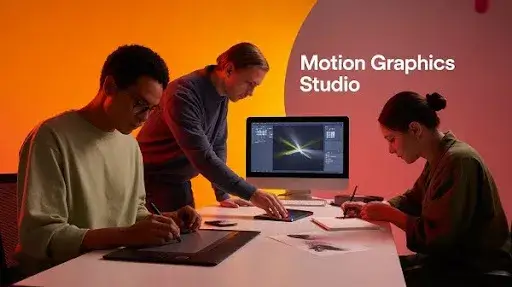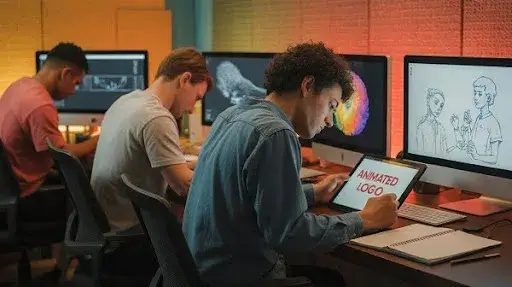Ever had a video stop you mid-scroll — not because of what it said, but because of how it moved? That’s motion graphics pulling you in. They’re not just spinning words or glowing boxes. They’re tiny pieces of design strategy that grab attention long enough to deliver a message.
For a business, a creator, or even a solo freelancer, choosing the right types of motion graphics can decide if someone skips your content or sticks around to watch.
And here’s the thing: you don’t need fancy gear or a huge team. A good idea paired with smart design choices is all it takes to turn flat visuals into vibrant motion graphics that explain, convince, or entertain.
What Are Motion Graphics?
So, what are motion graphics? In the simplest terms, they’re graphics that move. A logo sliding in, text bouncing with rhythm, charts that grow as data is revealed — all of these are motion graphics animation.
Unlike full-blown cartoons or films, motion graphics usually skip characters and plot. Instead, they rely on typography, colors, and shapes to carry the message. That’s why you’ll see them everywhere — from explainer videos and brand presentations to animated ads or promotional videos.
A 2D animation studio might create a snappy motion graphics video for social media, while teams offering 3D animation services often use the same approach to show off a complex product in detail. Different styles, same purpose: design in motion gets attention.
Why Motion Graphic Styles Work for Brands
Here’s why motion graphics are hard to ignore:
- They hook people almost instantly.
- They turn complicated ideas into simple visuals.
- They make content look polished and professional.
- They work for nearly any purpose — apps, education, sales, marketing.
Think about a plain pie chart. It tells you the numbers, sure, but it’s not exactly exciting. Now imagine that same chart spinning into place, slices sliding out one by one. Suddenly, the info doesn’t just make sense — it sticks.
Different Types of Motion Graphics Every Brand Should Know
Now for the fun part. These are the most popular types of motion graphics, each with its own style and purpose. Pick the one that matches your story, and it’ll do the heavy lifting for you.
1. Animated Typography
Words don’t need to sit still. With animated typography — or kinetic typography — letters move, stretch, bounce, or fade in with drama.
Why it works: movement gives words weight. A bold phrase feels even stronger when it comes alive on screen.
Best uses: lyric videos, opening credits, campaign slogans, or bold social posts.
It’s one of the most common types of motion graphics because it delivers impact without needing huge budgets.
2. Advanced Animated Titles
Titles aren’t just labels. They set the tone. Advanced animated titles take basic fades to the next level with layering, motion effects, and clean transitions.
Best uses: logo reveals, interview lower-thirds, end cards with calls to action.
When titles look this polished, they feel like a proper introduction — a confident opener that says the content is worth watching.
3. Animated Graphic Loops
Loops have a hypnotic quality. Animated graphic loops repeat endlessly, creating movement without needing a start or finish.
Where they show up: background slides in presentations, loading screens in apps, websites with liquid motion graphics for smooth flow.
Because they don’t stop, loops keep the design alive without pulling attention away from the main message.
4. Animated Ads or Promotional Videos
When it comes to selling, animated ads or promotional videos are hard to beat. They showcase products, highlight benefits, and build interest in ways static graphics never can.
Scroll through Instagram or YouTube and you’ll notice it’s usually the moving posts that get your attention. That’s motion graphics doing the heavy lifting.
Best uses: social campaigns, launch promos, quick explainer-style ads.
This is where both 2D animation studios and 3D animation services shine. Good pacing and smart design can turn even a dry subject into something people actually want to watch.
5. Product Animations
Words often fall short. Product animations don’t. Instead of describing a feature, you show it. Want to prove something spins 360 degrees? Rotate it on screen. Need to highlight components? Break it down visually.
Common examples:
- Full product rotations for online shops
- Exploded views that reveal inner workings
- Feature highlight reels
For e-commerce and SaaS brands, this type is a game-changer. Customers don’t have to imagine — they see the product in action.
6. UI/UX Animations
Interfaces feel better when they respond. UI/UX animations guide users, confirm actions, and make apps or websites more enjoyable.
Think glowing buttons, smooth swipes, or loading icons that keep you distracted just long enough.
These motion graphics designed for digital products aren’t fluff. They’re functional, keeping people engaged and making navigation feel natural.
7. Explainer Videos
Explainer videos turn confusion into clarity. They combine voiceover with motion graphics video to make tricky ideas simple.
Popular formats: step-by-step guides, animated company overviews, short product explainers.
Explainers are among the most shareable types of motion graphics. A page of text can feel heavy, but a 90-second animated breakdown feels easy to follow.
8. Transparent Animated Assets
Sometimes you need graphics that work anywhere. Transparent animated assets are perfect for that. With no background, they blend into any video, website, or slide.
Think icons that pulse, logos that animate, or call-to-action prompts that float in. They’re often included in pre-designed motion graphic templates, making them quick to drop in and customize.
For creators short on time, they’re a lifesaver.
9. Animated Infographics
Static infographics explain. Animated infographics persuade. When numbers grow, charts animate, or data points pop into place, people remember them longer.
Best uses: reports, corporate pitches, educational material.
This is where motion graphic styles prove their worth — turning dull stats into engaging visual storytelling.
10. Template Editing
Deadlines don’t always allow for custom work. That’s where pre-designed motion graphic templates save the day. Switch out text, colors, and logos, and you’ve got a ready-to-go motion graphics video.
They’re perfect for social ads, campaigns, and presentations where speed and consistency matter most.
11. Transition Animations
A hard cut from one slide to the next can feel abrupt. Transition animations fix that by easing the eye from one frame into another, keeping the story moving smoothly.
And no, it doesn’t have to be the standard fade-in. A transition can flip, slide, zoom, or even ripple like liquid. Those subtle shifts might look minor, but they stop your audience from mentally tripping over scene changes.
They’re especially handy in pitch decks, training modules, and video intros — anywhere flow matters.
12. Animated Icons
Icons aren’t just decoration anymore. Animate them, and suddenly they become cues that guide attention. Imagine a checkmark ticking itself or a chat bubble bouncing as if waiting for a reply — it instantly feels more alive.
Because they’re lightweight, animated icons work almost anywhere: apps, websites, explainer videos. Many motion graphics templates even include icon packs, which means you don’t need to build them from scratch.
Studios love them because they add polish without inflating budgets.
13. Animated Logos
Think about the last time a logo reveal stuck in your head. Chances are, it wasn’t a static image. When a logo moves — letters assembling, a line sketching itself, or shapes swirling into a symbol — it carves out recognition in seconds.
These aren’t reserved for global brands. Freelancers and startups use them too, often for YouTube intros or app splash screens. For anyone dipping into motion graphic styles, logo animation is a smart first step.
14. GIFs and Micro-Animations
GIFs may feel like internet veterans, but they’re still everywhere for a reason. A short loop that loads instantly and plays on repeat can grab more attention than a paragraph of text.
Micro-animations fall into the same family. A button that pulses when hovered over or an icon that shimmers before being clicked — tiny gestures like these make a product or design feel intentional.
For small creators, GIFs remain a go-to motion graphic type: cheap to make, endlessly shareable, and quick to deploy.
15. Presentation Motion Graphics
We’ve all sat through presentations that feel like static walls of text. Motion graphics change that. Bullets sliding in, graphs building dynamically, and animated transitions all help the audience stay tuned in.
That’s why teachers, marketers, and trainers keep using them — not for flash, but because motion helps ideas land and stick.
The Benefits of Motion Graphics
So, why bother with all this animation work? A few reasons stand out:
- They hold attention — people watch longer when things move.
- They clarify ideas — even complex topics get easier to digest.
- They look professional — motion adds polish.
- They flex everywhere — ads, demos, explainers, presentations.
- They boost recall — moving visuals leave stronger impressions.
Whether it’s a simple 2D explainer or a polished 3D render, motion graphics quickly show their value in how audiences respond.
How Motion Graphics Come Together
Behind every motion graphics video is a workflow, though not every project follows the same script. A typical one looks like this:
- Plan – define what the piece is supposed to achieve.
- Storyboard – sketch the scenes and timing.
- Design – build the visuals: text, icons, illustrations.
- Animate – add movement, pacing, and rhythm.
- Render – export a finished video.
Short on time? Templates let you jump straight into design and animation with ready-to-edit assets.
Styles Worth Noticing
Different styles set different moods:
- Minimalist – clean and distraction-free.
- Liquid motion – smooth, organic transitions.
- 3D motion – bold and detailed, great for product showcases.
Pick the style that matches your brand’s voice. A playful app might want bouncy icons; a financial firm probably won’t.
FAQs
What are motion graphics mainly used for?
Advertising, explainers, product demos, presentations, and branding.
Are they the same as animation?
Not really. Animation often uses characters and stories. Motion graphics stick to design-driven visuals like shapes, icons, and text.
Do I need a studio for this?
Not always. Templates cover many needs. A 2D or 3D animation studio makes sense when you want custom or complex work.
What’s the biggest perk for businesses?
Retention. A moving visual is easier to remember than a static one.
Which styles are trending right now?
Bold animated typography, logo reveals, and fluid, liquid-style transitions.
Final Words
Motion graphics aren’t just “nice extras.” They’re practical tools for getting people to notice, understand, and act. From subtle UI animations to full-blown explainer videos, they make ideas stick.
If your brand is still leaning on flat images, you’re leaving impact behind. The real benefits of motion graphics are stronger engagement, clearer delivery, and better recall.
At Prolific Studio, one of the best animation studios in Miami, we build motion that matches your goals — whether that’s a logo that lives and breathes, a sleek product demo, or a set of social-ready animations. We make sure your visuals don’t just look good; they get results.









